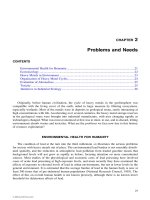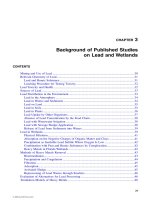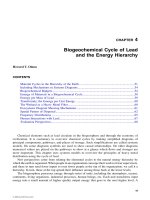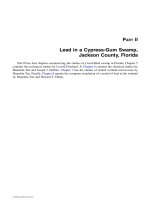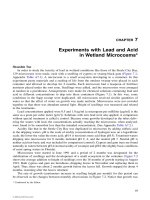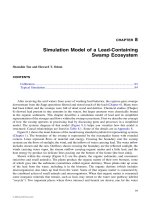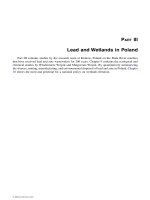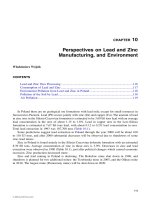Accumulation and transpotation of selected heavy metals in thermophilic anaerobic co-digestion of municipal sewage sludge and organic waste.PDF
Bạn đang xem bản rút gọn của tài liệu. Xem và tải ngay bản đầy đủ của tài liệu tại đây (847.16 KB, 8 trang )
VNU
fournal
of
Natural Sciences
and
Technology,
Vol.
29, No. |
(2073)
74-27
Accumulation
and
transpotation
of selected
heavy
metals
in thermophilic
anaerobic
co-digestion
of
municipal
sewage
sludge
and
organic
waste
Cao
Vfi
H*gt,
Bti
Duy
Camt,
Trinh
L€
Hirngt,
Bach
Quang
Dfrng2
tFaculty
of
Chemistry,
VNU
IJniversity
of Science,
19 LO Thdnh
T6ng Str.,
Hodn
Kiilm
Dist., Hanoi,
Vietnam
tvietno*
-
Korean
Centerfor
Environmental
Research
and
Training
(VKCET)
Vietnam Institute
of
Meteorologt,
HydrolgU
and
Environment
(IMHEN)
03
Ddng Thdi
Thdn Str.,
Hodn
KiAm Dist.,
Hanoi,
Vietnam
Received
06 March
2013
Revised
l4 March
2013;
accepted
29 March
2013
Abstract.
The aims
of this
research
focus
on accumulation
and
transportation
of
selected
heavy
metals
in thermophilic
anearobic
co-digestion
municipal sewage
sludge and
organic
waste on the
laboratory
scale. Organic
waste
was collected
from
market
and sewage
sludge
was collected
from
Kim Nguu
River
in Hanoi
city. Organic
waste and
sewage
sludge
were
mixed on
optimal
anaerobic
digestion
ratio. The
influent
substrate
was
put into experimental
equipment.
During
experiment,
some
parameters such
as
pH, EC
were measured
daily, others
parameters
such as
COD,
heavy metals
concentration
were
measured
after 3
to 5 days.
The
heavy
metals content
in
influent substrates
and effluent
substrates
were
paid more
attention
in this
research.
This
research discoved
that the selected
heavy
metals content
in
effluent
substrate
which
were
increased
with order
Cd>Pb>Ni>Cr>Cu>Zn.
The heavy
metal
content
is lower
in influent
subtrate
and higher
in effluent
substrate.
The
heavy
metals were
easily
bleached
in to
eluted solution
in 18
fust days
of themophilic
anaerobic
co-digestion
process
with order
Ni>Cd>Cu>Cr>Zn.
The results
of research
provided data
to
help readers
understand
clearly
about
characteristics
of
municipal
sewage sludge
in Hanoi.
Base
on results
of this
research
to develop
sewage
sludge
troatment
methods.
Product after
treatment
could
be used
as fertilize
for soil amendment.
Keywords:
thermophilic
anaerobic
digestion,
mwricipal
sewage
sludge,
organic
waste,
heavy metals
1.
Introduction
Heavy
metals
which
are metals
have
private
density
rather than 5glcm'.
From
wastewater
treatment
processes, heavy
metals
were
accumulated
in sewage
sludge.
The content
and
t-or rponaingauthor.Tel:84-904442426.
:
vn
characteristics
of sewage
sludge
depend
on
properties of
wastewater
sources
[2].
Urban
area in
Vietnam
where still
exist
a
lot
small
workshops
in the
city.
Therefore,
the
properties of
municipal
wastewater
are
complicated
which
lead to
complicated
composition
of
municipal
sewage
sludge.
Specialy,
the
heavy metals
contents
is very
high
in
sewage
sludge.
t4
C.V.
Htng
et al. I WU
lournal
of Nntural
Sciences and
Technology,
Vol.
29,
No.
1
(20L3)
L4-21
t5
Now
a day,.
treating municipal sewage
sludge
is necessary in
Vietnamese urban area.
However, finding
the suitable
treatment method
to
orient reduces, reuses and recycles
are
difficult. In order to meet this requirement need
to
implement
more investigation on municipal
sewage
sludge.
For
example,
in
Japan where
have high
technology in
development of
municipal
treatment method. After treatment, the
municipal sewage sludge
was
used arcund 30Yo
of
mass as fertilize. This ratio will
be
raised in
the future
[5].
In
this
research, focus
on accumulation and
transportation of selected heavy metals in
thermophilic anearobic co-digestion
of
municipal sewage
sludge
and
organic
waste.
Results ofresearch are
provided
data to develop
treatment method with airn to use
product
as
fertilizer for
soil amendment
[4].
2. Material
and
methods
2.1.
Pilot equipment
The
pilot
equipment consists of single
cylindrical reactor
(diameter
0.6m,
height 0.8m)
made from
stainless steel
with
available
volume
is 40 liters
(fig.
l).
The
out site
is
heat
keeping layer. The
reactor also is equipped with a thermal
insulation
and the temperature
is kept constant
at
55'C
(thermophilic
condition). Gas
volumetric flow measurement is used to
measure
gas
volume after 24 hour.
The
effluent substrate
was
sampled
daily
though valve
in
the bottom of
reactor
and
pH,
EC were measured. Others
parameters
such as
COD, heavy metals
were
measured after 3 days
to 5 days
follow
experiment
plan
in
order to
assess the stabilization
process.
Fig.l.
Photo
of the
pilot
equipment.
2. 2. Substrates characteris tics
The anaerobic co-dieestion involved two
different substrates:
-
The municipal sewage sludge
was
sampled
from Kim Nguu River near from Lac
Trung Bridge.
-
The organio waste comes from market.
Municipal sewage sludge was removed inert
substances such as bridges, stones, special solid
waste
after collection. The
sewage sludge
has
to be smooth to avoid obstructed in reactor.
The organic fraction has
quite
variable
characteristics however its average
composition
can be roughly estimated as
30%o
animal origin
and 70o/o vegetable origin. It was
grinded
by
grinding
machine and mixed
with municipal
sewage
sludge follow ratio three
part
of organic
waste by volume and one
part
of municipal
sewage sludge
by volume
before
put
into reactor.
Table l. Input subshates composition
r
'
,' r
Vuss Vo*
v
inFsrbsrde
\L/
(%) (%\
DMSS(s/rrrl)
(?il)
25 75 t.441 1.247
VMSS: Volume
of
municipal
sewage sludge;
VOW:
Volume of organic waste; DMSS: density of municipal
sewage
sludge; DOW: density of organic waste.
30
t6
C.V. H*ng
et
aI. / WIJ
Journal
of Natural
Sciences
and
Technology,
Vol.
29, No.
1
(201'3)
14-21
2.3. Methods
The
experiment
was implemented
in batch
type
with optimal
ratio of
municipal
sewage
sludge
and
organic
waste
is l/3
for anaerobic
digestion
t6].
The
component
of
influent
substrate
was shown
in table
1.
EC
and
pH
value
were
determined
bY
Eutech Con 700
and
Cyberscan
pH
110.
COD
total
was determined
by titraction
with
KzCrzOz
method.
Heavy
metals
were
determined
by
ICP
OES
method.
Preparing
solid
samples
for
heavy
metals
determination
After
sampling,
samples
were
dryed
at 60oC
during
24
hours.
After
that,
the samples
were
grinded
and
kept
in anti-moisture
vase.
Each of
samples
was scaled
one
gram and
put
into
Teflon
tubes.
Continuoustly
put
9
ml
HNO3
acid 620/o
and
I
ml HzOz
30oh.
T\e heating
mechanism
of microway
oven
was
divided
two
steps:
Step
1: the temperature
need to
reach
165"C
around
2 minutes,
the max
pressure could
be
350
psi,
retention
time
is
4 minutes.
Step
2: The
temperature
need to
reach
175oC
around
3
minutes,
the
max
pressure
could
be 350
psi
retention
time
is 20
minutes.
The samples
were cooled
automatically
to
ambient
temperature.
After
that
they
were
determined
by
ICP OES.
Preparing
eluted
solution
for
heavy
metals
determination
Scale
exactly
10g
dry substrate
and
put
into
bottle
250 ml,
add 100
ml distilled
water
and
shake
around
24
hours.
After
that,
use spin
filter to
collect
eluted
solution
and
filled by
filter
paper
before
determination
of
heavy
metals content
by ICP
OES
method.
3. Results
and discussions
3.1.
Variations
of
pH
and
EC
value
Eo
A
7,4
7,6
7,a
7
6,4
6
,+PHi
Time
(day6)
Fig.2.
Variation
of
pH
value.
The
variation
of
pH'value was
shown
infig.2.
This
variation
is
characteristic
of
anaerobic
digestion.
In
the
first
phase,
pH value
has
decreasing
trend.
It is suitable
to organic
compound
digestion
[3].
The
lowest
pH value
in
this experiment
is 6.78
after 9
days.
During
digestion,
pH
value
continoustly
increases
and
stable
at the stability
phase
ofdigestion
process.
5 9 t3
17
21
25 A 837
41 15
49 S 5761 S69
n 77 01
S
^
1300
t
rroo
!, 39oo
3700
3500
3300
31 00
2900
2700
2500
Tlm
(days)
Fig. 3.
Variation
of
EC value
.
C.V.
Httng et aI. l:'.l
lJ
lournal
of
Natural Sciences andTechnology,
Vol.29, No.
1
(2013)
14-21
17
The variation
of EC value
is suitable
rule of
anaerobic digestion.
Firstly,
EC value
usually
increases. After
that, it decreases
and stable.
3.2.
Variation of COD|
e
100000
P
[
,*oo
a
80000
70000
60000
5oom
40000
0 5 t0 t5 20 25 30
35 40 45 50
55 60 65 70 75 60
65 90
F_:SqQ,fqLr*ri
l
rime(daF)
Fig.4. Variation
of CODI
value.
Figure
4
shown
variation
of CODI
depend
on time.
This variation
is suitable
to anaerobic
digestion.
In the first
stage CODt
increase
in 5
to
l0 days
and decrease
during
anaerobic
digestion
take
place.
The variations
of
pH,
EC, CODI
during
digestion
process affirm
that the
process take
place
in this
experiment
that
is anaerobic
digestion.
3.3.
The accumulation
and
transportation
of
selecled heavy
metals
Accumulation
of
heat'y
metals in
municipal
sewage
sludge
Municipal wastewater
in
Hanoi city
not
only contains
household
wastewater
but
also
contains
wastewater
from small
workshops.
Therefore,
the
properties of
municipal
wastewater
are very complicated,
Similar
to
popular wastewater
treatment
process, municipal
wastewater
though out
sewage
system that
take
place
process
such
as
physical
processes, chemical
processes
and
biological
processes
[1].
The accumulation
of
heavy
metal
in sewage sludge
depends
on
characteristic
of
wastewater treatment
plant
system
and
its
operation
[2].
Therefore,
the
accumulation
of
heavy
metals
in municipal sewage
sludge
is different
on each of
zones as
well as each of
country.
The
transportation
of
heavy metals
Transpoftation,
biological
characteristics
or
toxic
behaviours
of
heavy
metals mainly
depend
on chemical
properties of each
heavy
metal
as
well as compound
forms
of heavy
metal in sewage
sludge
[1].
It
is difficult
to
determine
a
suitable
method
for treatment
municipal
sertage
sludge
with
orient
using
product to
soil amendment.
Therefore,
it is
necessary
to
pay
more attention
to compound
form of
heavy
metals in sewage sludge
as
well
as its transportation
during treatment
process
[l].
Efficiency of
removing
heavy metals
from
sewage
sludge depends
on compound
form
of
heavy
metals. Usually,
heavy
metals exist on
a
lot of
compounds
such as
sunfide,
hydroxide,
silicate,
coordinate
form
with organic
legends.
There
are a lot of
mechanisms
effect on
transform
of
heavy metal
compound
in sewage
sludge
which are effect on
transporting
and
bleaching
of heavy
metal from sewage
sludge.
In
which,
it is necessary to
pay
more attention
to heavy
metal mobilization
mechanisms
in
sewage
sludge
treatment
by anaerobic
digestion.
The
microorganism
activities
oxidized
sunfide compounds
which
promote
bleaching
of heavy
metals into aqueous
phase.
Transpoftation
mechanism
follows equation:
Thio-oxidans
MeS
+
2O.t: MeSOa
l8
C.V.
Hung et al. / WU
lournal
of Natural
Sciences and
Technology, Vol.
29, No.
1
(2013)
14-2'1
Though this
mechanism,
heavy metals
exist
on sunfide
form in sewage
sludge
such as
NiS,
CuS, ZnS could be
bleached
[1].
However,
the microorganism
activities
are
affected by conditions
of treatment
process
such
as temperature,
pH,
and initial
substrate
component. Treatment
process is implemented
in thermophilic
that
have heavy
metals
bleaching
rather than mesophilic
condition.
The
pH
value not only
effect on
healy
metals
bleaching
follow chemical
mechanism but
also
indirectly effect
on microorganism
developing
that cause to effect
on transformation
of
healry
metals in
substrate.
Thus. affirm that
the
accumulation
and
transportation of
heavy metal
in treatment
process
depends
on initial
substrate
and
technology
conditions.
o 5 1j 17 27 $ 43 55
6t 71 79 67
rh.
{d.y.l
F-l;l:::l!':
Fig. 7,
Variations of Cu
content
in
dry
substrates
and eluted
solutions.
t
fg
is
a
s.
ru;
,*
EE
E
'sE
l@o
s
a
m
1s
1@
M
7m:
m
3a
ru
ie
4mI
w!
ro
lm
0
t
?r{
;E
14
:E 1@
t
tm
4
m
o
l1m
T
f,
140
gs',0
i9
tm
f;m
L60
40
x
0
_i
: ll
i7 zr
% 43 55 61
71
7e
07
rrh'
(d!v')
I
-
N
in dy .u*tal +Ni In duld !ddr6
ie
>i
:E
g
E
0 5 11
'17
27
36 43 55 61 71 79
87
nm(dayr)
i
J-,"0o*,a*
'"i""o""'*f
Fig. 5.
Variations of
Cadmium
content
in dry
substrates and eluted
solutions.
2m
150
1m
50
0
0 5 11 17 27 38
43 $ 61 71 79 87
Tlme
(fiy.|
Fig.
6.
Variations of Chromium
content
in dry
substrates
and eluted solutions.
Fig. 8.
Variations of Nickel content
in dry substrates
and eluted
solutions.
&
&
40
&
0
05111727$435561
sr
Tlh.
{d.yt)
-Pb
h dry subskal +Pb
n 6lul* sdulrd
Fig. 9.
Variations of Lead content
in dry substrates
and eluted solutions.
I
lld
1i
ii
!9
E
l-br4Dnrd-
Fig.
10. Variations of
Zinc content
in dry substrates
and eluted
solutions.
60g
; iE
d
2Qt
10
0
&
m
T
!;
I
o
6
ru
I=
re
!
8
riirc
1200
1m
m
ffi
m
2@
0
'*i
@t
!
m
3t
I
4Mi
*I
E
600
g soo
E
roo
i
soo
: 200
t
100
0
CdOOTNFbZn
E
H€W metals content
in lnitial samples
I Ilil il
C.V.
turng et al. / WIJ
lournal
of Natural Sciences
and Technology,
VoI. 29, No. L
(201.3)
1.4-27
l9
The increasing
percentages
of heary
metals
content follow the
order Cd>Pb>Ni>Cr>Cu>
Zn.
b
H.""y *trla
EA€qe
reent4€s
hry
metals deased In ficl 18 days
rAEq€
re€nt4es
baw
melds desd der 10 drys
Fig. I L Heavy metals content
in initial substrate.
Fig.13.
Average
heavy metals released.
Fig. 13 descriped
the average
releasing of
heavy metals
in first
18
days
is higher than
after
18 days of
treatment
process.
This
phenomenon
is
quirely
appreciate
to decreasing
of
pH
value
in l8 first
days of treatment
process.
In the
first
stage,
the organic
digestion creates
organic
acids and
ammonium that
have high coordinate
abilities
with
heary metals.
pH
value increases
in after stage
of treatment
process
but the
releasing ability transporting
into
aquatic
phase
of heavy
metals
was lower
than
first stage.
Therefore,
this research
shown that all selected
healy metals easily
transporting
into aquatic
phase
during
18 first days of treatment
process.
ln which, the
transporting ability
follows order
Ni>Cd>Cu>Cr>Zn.
4. Conclusions
Though
researching
results,
we
could
conclude
like that:
The accumulation
and
transportation
of
selected
heavy metals
in thermophilic anearobic
co-digestion
of
municipal sewage sludge
and
organic
waste depends
on a lot of factors
such
as initial
substrate characteristics,
technology
coirditions,
implement
method. . .
^
100
:l
^^
g-^
J^n
5"'
Eso
i,"
I.^
o
820
Ito
0
:(
E
!
I
80
Fig. 12. Heavy
metals increasing
in effluent
substrate.
This
research shown that
anaerobic
digestion
is the cause to
increase heavy
metals
content
in effluent substrate.
During anaerobic
digestion,
the
biodegradation
of organic compounds
with the
end
products
such as CHa,
CO2,
NH3 also heavy
metals are
not
biodegradable
and negligible
evapour. This is
the main cause
to make
increase heavy
metals content
in dry effluent
subtrate
[2].
Fig.12 shown
that the
lower heavy
metal
content
in initial substrate
the higher
heavy
metal content in effluent
substrate
after
treatment
process.
20 C.V. Htng
et aL / WU
lournal
of Natural
Sciences and Technology,
Vol. 29,
No. 1
(2013)
14-21
Experiments
shown
that heavy metals
content
of effluent
substTate increase
after
treatment
process
follow
order
Cd>Pb>Ni>Cr>
Cu>Zn.
Heavy metal
content is
lower in initial
substrate,
it is higher
in effluent
substrate after
treatment process.
This research
shown
that all
selected heavy
metals
easily
transport into
aquatic
phase
during 18
first
days of treatment
process.
In
which,
the transport
ability follows
order
Ni>Cd>Cu>Cr>Zn.
This
research
contributed
data about
characteristics
of municipal
sewage
sludge.
Base
on
collected
data to build
suitable
releasing
heary
metals
method in
treatment
process.
The
product
of treatment
process
could
be
used for
soil amendment.
References
tll
Ashish Pathak,
M.G.
Dastidar,
T.R.
Sreckrishnan,
Bioleaching
of heavy
metals from
sewage
sludge: A review,
Joumal of
Environmental
Managemenr
90
(2009)
2343-
2353.
Kangala
B. Chipasa,
Accumulation
and fate of
selected heavy
metals in
a biological
wastewater
treatment
system, Waste
Management
23
(2003)
135-143.
B. Bilitewski,
Georg Haerdtle, Klaus
Marek,
Waste Management,
Springer, 1
994.
Brian J. Alloway,
Andrew
P. Jackson, The
behaviour of heavy
metal in
sewage sludge-
amended
soils, The
Science of the Total
Environment,
| 00
(1991)
1
5l-176 l5l,
Ayumiito, Teruyuki
Umita, Jico Aizawa,
Toshiyuki
Takachi, Koji Morinaga,
Removal
of
heavy metals
from anaerobiccally
digested
sewage
sludge by a new
chemical method using
ferric sulfat, Wat.
Res. Vol.34,
No.3,
pp.75
l-
758. 2000.
Cao Vu Hung,
Bui Duy
Cam, Thermophilic
anaerobic
co-digestion
of source
selected
organic waste
and municipal
sewage sludge:
Case study in Hanoi, International
Conference
on Sustainable
concepts for
Industrial
wastewater
treatment and
Industrial zones
management
(SCIWT
2012,
October l0
-
ll,
2012. Hanoi.
Vietnam.
l2l
t3l
t4l
L"l
t6l
Sg
tich tu vd
vfln
chuy6n
cua mQt
sO
kim
loai nAng
trong
qu6
trinh 6n
dinh birn
thai
t6t
ngp r6c
hiru
co
bdng
phucrng
ph6p
l€n
men nong
Cao
Vfl
H*gt,
Biri
Duy
Camr, Trfnh L0
Htngr, Bach
euang
Dfrng2
tKhoa
hda hoc, Trudng Dai
hoc Khoa hoc
n{ nhiAn, DHQGHN,
t9 LO Thdnh
T6ng, Hodn Kitim,
Hd NQi, ViQt
Nam
tTrung
tdm Nghiin
c*u Ddo
tqo Vi€t Nam
-
Hdn
QuiSc IKCET)
Vi€n
Khoa hoc Khi trong
Thuy vdn
vd M6i trudng
(IMHEN)
Trong
nghi€n
criu ndy
tflp trung nghi€n
cr?u sg
tich t.u vd v4n
chuytin
cria mQt s6 kim
logi n{ng
trong
qu6
trinh
6n tllnh
btn thai k.it hqp
v6i r5c hfru
co bing
phuong
ph6p
l€n
men n6ng
tr6n
qui
md
phong
thi nghi€m.
R6c thAi
hiru co clugc lga
chon vd
bin thAi tluqc l6y
tir hQ thdng
s6ng tho6t
nudc
thdnh
ph6
trdn
tlia bdn
thdnh
ptrO
Ha
NOi. R6c hiru
co vd
bun thAi duoc
pnO;
tr6n voi
ry lQ thich hop
C.V. Htmg
et aI. /WU
lournal
of Natural Sciences andTechnology,Vol.'29,
No. 1
(2073)
L4-21
2l
theo
hu6ng ttii uu
qu6
trinh
phAn
hriy
y6m
khi. H6n
hqp bin thii vdrbc hftu
co dugc dua vdo m6 hinh
thi nghipm hogt
ddng theo kii5u m6.
Trong su6t
qu6
trinh ti6n hdnh thi nghi€m
c6c chi ti€u nhu
pH,
dq
ddn diQn
(EC),
th€
tfch khi biogas
(Vbiogas)
clugc do hdng ngdy,
c6c chi sti kh6c nhu
COD t6ng, kim
lo4i
ning dugc do djnh k!
theo k6 ho4ch th\rc nghiQm.
Hdm lugng kim loai
trong dAu vdo vd
sin
phAm
dAu ra
cria
qu6
trinh xri lf duoc
<tic biet
quan
tAm trong nghi€n
cr?u.
Nghi6n
cr?u dd chi ra dugc c6c kim loai
ndng c6 hdm lugng
ting l€n trong sdn
phAm
sau
qu6
trinh
6n ttinh v6i
thf tg sau:
Cd>Pb>Ni>Cr>Cu>Zn, kim loai
cdng c6 hdm luqng
th6p trong nguy6n liQu
dAu vdo, c6
phAn
trim tlng cirng cao
trong sin
phAm
sau 6n tlinh. Nghidn
cfu cfing tld
chi
ra
ciic
kim
1o4i n[ng
d6 ddng v{n
chuy6n vdo
pha
nu6c hon trong
giai
tlo4n 18 ngdy dAu cria
qu6
trinh 6n dinh v6i
thf t.u linh
cfQng cria c6c kim
lo4i nhu sau: Ni>Cd>Cu>Cr>Zn.
Ktit
qu6
cria nghiOn
criu
g6p phAn
hi6u
s6u hcrn
.rrd
birn thii tho6t nudc tlii5n hinh
tai Hd NOi tr€n co
sd d6 <t€ xu6t
phuotrg
5n thich hqp
cho
viQc lo4i
bd
kim
topi n{ng ldm tiAn dO
sri dpng sdn
phAm
sau xft ly cho viQc
cai tao d6t ndng nghi6p.

